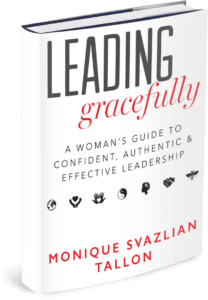Assertive vs Aggressive: 5 Tips for Women Walking the Tightrope
The one question that I get asked the most as a women’s leadership coach is how to walk the tightrope and find balance between being aggressive and assertive in the workplace. This also happens to be one of the main themes in my book, Leading Gracefully, which presents a whole new roadmap on how women can achieve that sometimes elusive balance.
One of the biggest challenges women face is something called the “double bind” which are the confusing messages they get about how to behave in a work environment. Women are told they need to be assertive, but not too much, otherwise they might be seen as a “bitch” or “difficult to work with” or an “Ice Queen.” However, if they are too accommodating, then they might get labeled as the “Nice girl.” Each of these polarities make up two ends of the Leadership Tightrope and both sides of this spectrum have pitfalls and force women to choose between being respected versus being liked, which ends up being a zero sum game.
The Nice Girl vs The Ice Queen
What happens when you get labeled as the nice girl? Sure, people may like you because they know you’ll be responsible, take care of all the office housework and not mess up their Starbucks order, but when it comes time to assign challenging projects or take on more responsibility, you’re most likely not going to be top of mind for people. On the flip side, when we’re on the other end of the Tightrope, people may not necessarily like working for you or with you because you might come off as cold and unemotional. Sure you are respected, but what happens when there’s a fire? Will you hear about it? Most likely not, because people are most likely intimidated by you and could be afraid of an aggressive reaction. There are trade offs on either side of this Leadership Tightrope and they are both bad for women’s advancement. And this is one of the main reasons we continue to see a leadership gap in organizations today because it seems as if women are damned either way, so they either check out, opt out of their careers, or worse yet, burn out from having to constantly manage their image and perception.
So it’s really easy to give up and say, “well there’s not really much I can do and men need to change the way they stereotype women.” My answer to that is – yes and no. Do men need to check their gender bias at the door? Absolutely? Do organizations need to make sure men have the tools to do so? Yes. However, women can also work on their effectiveness by finding balance between being the Ice Queen or the Nice Girl through practicing Feminine Leadership. When practicing feminine leadership, women are able to take back control of their impact through building self-awareness and leaning into the strengths they bring to the table.
Defining Assertiveness
Let me start my defining assertiveness. Being assertive means being able to clearly and confidently communicate your ideas, influence others, and contribute fully. It means being direct, being able to make decisions and having the courage to speak up when you don’t agree or have a strong opinion about something. Now the way we do this can be the difference between being assertive and being too aggressive. The tone of voice we use as well as our body language and facial expressions make up about 80% of what people perceive of us. To be able to be assertive means our body language is aligned with our thoughts and we are able to articulate them with confidence and ease. This means we feel calm and centered in our body. It means that our body language is open and receptive. We are able to listen deeply and acknowledge others. We allow others to express their opinions and give others credit for their input.
How does this differ from being aggressive? When we are aggressive, we tend to leave our emotions at the door. There isn’t much empathy or kindness in the way we speak, we might be rude or indifferent and our body language might be more closed rather than open and receptive. We might roll our eyes or cross our arms for example. We might not listen well to others or rudely interrupt. We might be demanding and not really give people the credit they deserve. Although you are direct and vocal, the tone of voice you use and the energy behind it is very different. It is much more controlling and dominating and makes people feel intimidated, afraid and uncomfortable.
Here are five steps you can take to be more assertive and less aggressive:
1. What is my current impact?
Self-awareness is the key to personal and professional development, so we start there. Most of the time, we don’t have any clue about how we are showing up and how others perceive us. Depending on your level, you may or may not be getting feedback about your performance or leadership style. So it’s imperative that you develop self-awareness and ask yourself, what is the impact I am having on the people on my team, on my peers, direct reports, or others I interact with on a daily basis. Begin noticing how people react to you and whether you are creating a healthy or toxic environment around you through your actions and behavior. Are you a team player and get along well with the majority of your team or do you complain and act a victim? Are you able to communicate your ideas well or are you more emotional and volatile? How do you handle stress? Begin noticing your impact and be honest with yourself. If you don’t like what you see, that’s okay. You can’t change what you don’t see, so this is the first step in choosing behaviors that bring you to the desired impact you want to have.
2. What is my desired impact?
Once you’ve given yourself an honest assessment (or taken a 360 Leadership Assessment), you can ask yourself – What is the desired impact I want to have? Do you want to be more collaborative with others? Do you want to build more trust with your peers? Do you want to improve a relationship with someone you work with? Do you want to be a more assertive and less aggressive woman? Write down the types of impact you want to have on the various groups of people you work with (peers, direct reports, manager, customers etc). This will give you a goal or objective to work towards and you can then work backwards to figure out what qualities you need to develop in order to get to your desired impact.
3. Practice Centering
At the center of the Feminine Leadership model is the quality of Centering. If you’re wondering what that is, think about how you feel after a yoga or meditation class. You probably feel more grounded, present, calm and relaxed. That is what we mean by Centering. Most of the time we are in some kind of stress response during the work day. We have to run from one meeting to the next, constantly put out fires and handle many demands. All of these put stress on the body which significantly reduces our ability to think clearly. When we are in a stress response we might respond more emotionally or aggressively. However, we can quickly get out of that stress response by practicing a Centering exercise (there’s a great one I recommend in my book), or you can find an easy practice that you enjoy like deep breathing exercises or going for a quick walk around the block or listening to relaxing music. Find a practice that works for you and do that before you respond to an email, resolve a conflict or walk into an important meeting or presentation.
4. Choose a leadership capacity(s) to develop.
Once you’ve Centered, you can then ask yourself – what leadership quality do I need to use in this given situation so I can have my desired impact? You can then refer to the Feminine Leadership Model to ask yourself what qualities will help you get to your desired impact. If you tend to be more aggressive in your leadership style, perhaps you need to practice more empathy and humility in order to achieve your desired impact. If you tend to be more shy and withdrawn, then perhaps you need to be more direct and become assertive in how you communicate your ideas and opinions. Pick one or two leadership qualities from the model that you think will help you balance out your impact and commit to working on those for the next few months. Use the specific exercises outlined in my book to help you do so or book coaching sessions with me directly if you want further support.
5. Ask for feedback.
A great way to know whether you’re on the right track is to tell people you work with that you are working on a specific leadership quality. This will help you stay accountable and get feedback on your progress. Not only will you be acting as a role model for self-development, but you’ll also be getting valuable feedback on the changes you’re trying to implement in your leadership style. This insight can be pivotal to your success when you’re working on behavior change because it gives you the positive reinforcement to keep going and also helps you gauge if you’re on track to achieve your desired impact.
You Are Always at Choice
One of the most valuable things you can discover is that you are always at choice at how you show up, whether you lead others or just lead yourself. Whether you’re a manager, an entrepreneur or a mom, you can practice these leadership skills to better manage yourself and others with more ease, grace and effectiveness. Sometimes all it takes is the willingness to look at ourselves honestly in the mirror and ask ourselves some tough questions. But in the end, doing the work to improve your effectiveness can mean the difference between staying stagnant in your career or moving upwards, making more money, and being more successful in your endeavors. For women to move up the ladder and close the gender gap, we must learn how to assertively and confidently communicate, offer our opinions, and contribute our gifts fully. I hope these steps will help you not only be liked but also respected by the people you work with and relate to.

























